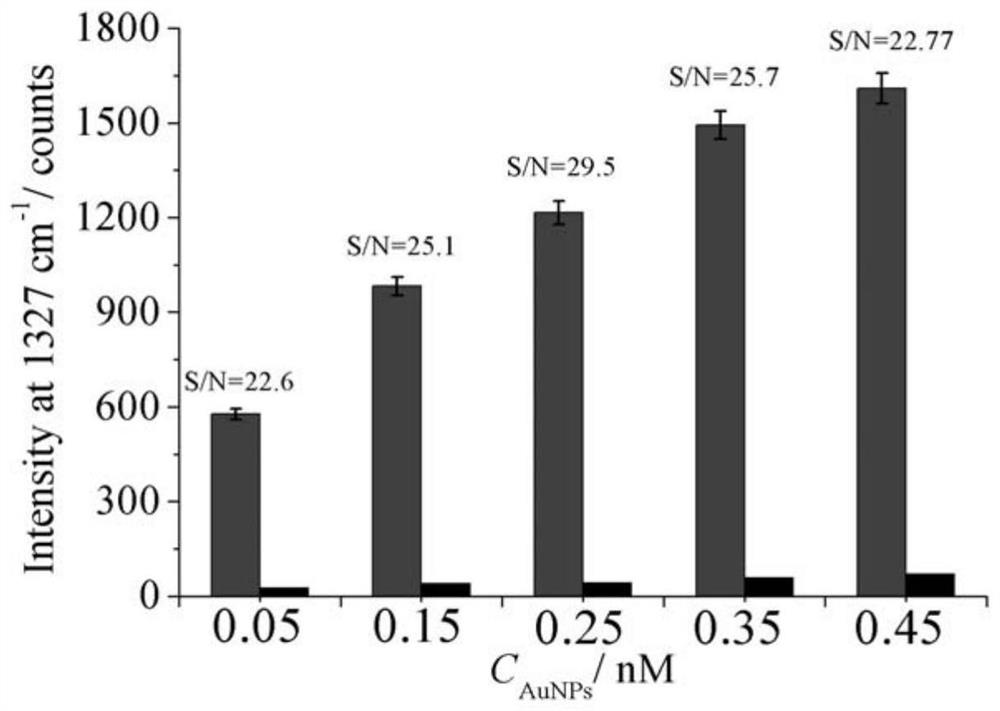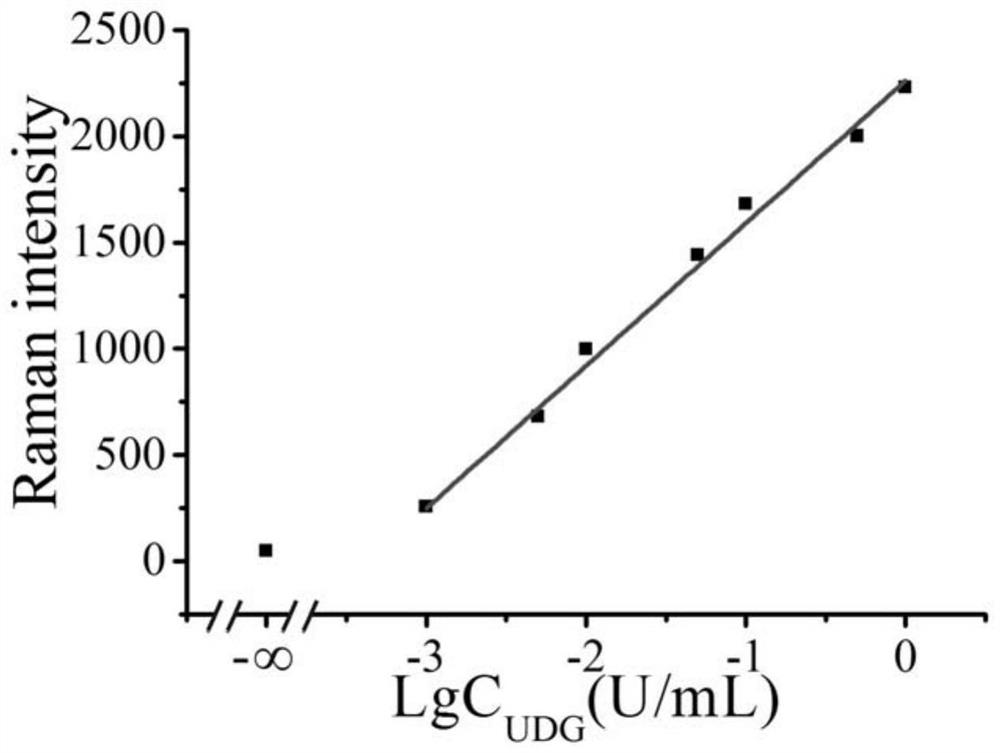A biosensor for detecting uracil glycosidase (UDG) activity and its preparation method
A technology of uracil glycosidase and detection method, which is applied in the direction of instruments, measuring devices, scientific instruments, etc., and can solve the problems of easy bleaching of fluorescence detection and low accuracy of colorimetric detection
- Summary
- Abstract
- Description
- Claims
- Application Information
AI Technical Summary
Problems solved by technology
Method used
Image
Examples
Embodiment 1
[0043] Example 1 Pure UDG concentration detection
[0044] 1. Modification of Raman dye and hairpin probe DNA onto the surface of gold nanoparticles:
[0045] a. Take 1 mL nano-gold solution in a centrifuge tube, centrifuge for 10 min, and centrifuge the two tubes at the same time for later use. Centrifuge until the supernatant is colorless and transparent, remove the supernatant, and add 300 μL of sterile water to concentrate the nano-gold solution to 3 nM. Transfer to a 1 mL glass vial, seal it with tinfoil, and add 12 μL of Raman dye (4-NTP) with a concentration of 0.25 nM.
[0046] b. After standing at room temperature for 30 min, add 150 μL of -SH-modified substrate probe (hairpin DNA) with a concentration of 30 μM, mix well, and place at 4 °C for 24 h.
[0047] c. Slowly add 50 μL of PB buffer solution (100 mM conventional phosphate buffer solution, pH=7.4) several times, add magnets (soaked in aqua regia the day before) and stir for 10 min, then continue to add 27 μL ...
Embodiment 2
[0052] Embodiment 2 optimizes Raman dye concentration to improve signal-to-background ratio
[0053] 1. The steps for modifying Raman dyes and hairpin probes (-SH) to the surface of gold nanoparticles are as follows:
[0054] a. Take 1 mL nano-gold solution in a centrifuge tube, centrifuge for 10 min, and centrifuge the two tubes at the same time for later use. Centrifuge until the supernatant is colorless and transparent, remove the supernatant, and add 300 μL of sterile water to concentrate the nano-gold solution to 3 nM. Transfer to a 1 mL glass bottle, seal it with tin foil, and add 12 μL of different concentrations of Raman dyes (4-NTP).
[0055] b. After standing at room temperature for 30 min, add 150 μL of hairpin probe modified with -SH with a concentration of 30 μM, mix well, and place at 4 °C for 24 h.
[0056] c. Slowly add 50 μL of PB buffer several times, add magnets (soaked in aqua regia the day before) and stir for 10 min, then continue to add 27 μL of PBS bu...
Embodiment 3
[0062] The UDG concentration in the mixed solution of embodiment 3 actual measurement
[0063] 1. Steps for modifying Raman dyes and hairpin probes (-SH) onto the surface of gold nanoparticles:
[0064] Same as in Example 1, the hairpin probe and Raman dye were modified onto the surface of gold nanoparticles.
[0065] 2. Measure the concentration of UDG enzyme in the mixture
[0066] a. Mix the labeled gold nanoparticles solution (12 μL), endonuclease IV (2 U / mL), 10×NEBuffer (10 mMTris-HCl, 50 μM NaCl, 10 mM MgCl 2 , 1 mM DTT, pH 7.9) 2 uL, water, and crude cell extract were added to centrifuge tubes, shaken for 30 s, and placed in a water bath at 37 °C for 60 min.
[0067] b. After 60 minutes, take out the mixed solution from the water bath, observe the color change, and detect the peak intensity with a Raman spectrometer, and detect the target object accordingly.
[0068] The test results are shown in the table below. It can be seen that when the concentration of UDG is ...
PUM
| Property | Measurement | Unit |
|---|---|---|
| molecular weight | aaaaa | aaaaa |
Abstract
Description
Claims
Application Information
 Login to View More
Login to View More - R&D
- Intellectual Property
- Life Sciences
- Materials
- Tech Scout
- Unparalleled Data Quality
- Higher Quality Content
- 60% Fewer Hallucinations
Browse by: Latest US Patents, China's latest patents, Technical Efficacy Thesaurus, Application Domain, Technology Topic, Popular Technical Reports.
© 2025 PatSnap. All rights reserved.Legal|Privacy policy|Modern Slavery Act Transparency Statement|Sitemap|About US| Contact US: help@patsnap.com



